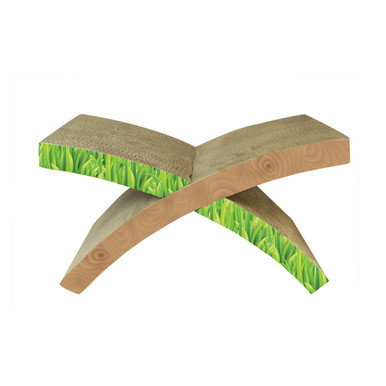Imagine your cat stretches long and lean. Their claws catch in the rug, but they don’t seem to mind. You might inwardly groan as your cat picks at the carpet and then saunters over to the doorframe, claws outstretched. You know what’s coming next.
Why DO cats scratch? You may wonder to yourself. Or, how can you encourage them to scratch something else — like a scratching post?
First, it turns out that cats can’t help scratching. It’s a basic cat behavior. It’s a biological need like eating or grooming themselves. There’s nothing wrong with your cat scratching as long as they don’t destroy your furniture with their claws.
Scratching behaviors fulfill several needs for our furry felines.
- Let’s them “mark” their territory
- Keeps the claws sharpened (handy for hunting)
- It’s good exercise
As an informed cat parent, it helps to understand the psychology behind why cats scratch, and how you can train them to scratch where you want them to — and not your favorite chair. Rest assured, cat scratches on your furniture have nothing to do with revenge.
Cat Scratching Is Territorial
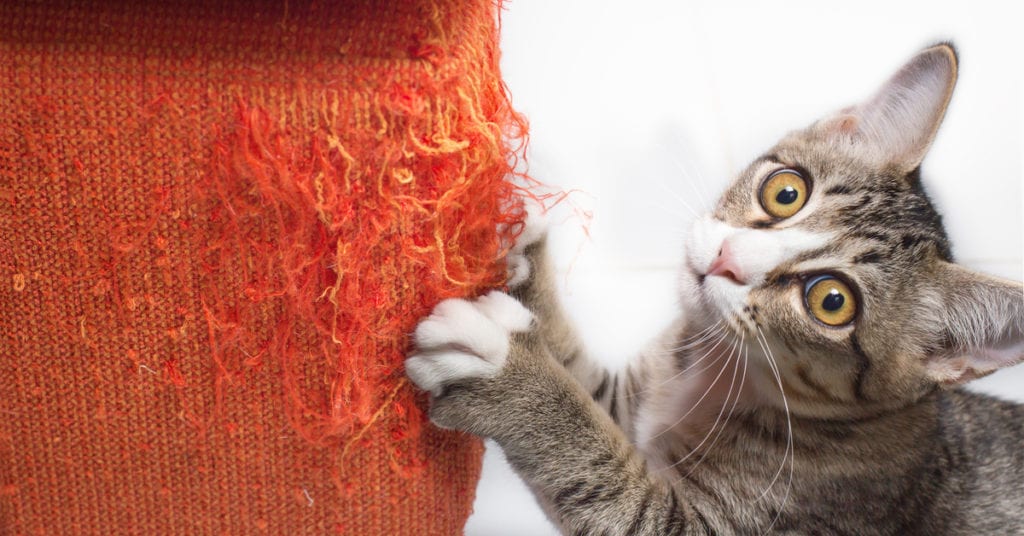
Kitties are territorial. Part of their scratching behavior designates their claim. Your cat may scratch trees outside your home’s entrance, your door or doorway, their litter box, carpeting inside, and furniture.
Not only do they leave claw marks, but they also leave a scent behind. Their paw pads have scent glands called pheromones. Other animals can both see the scratch marks and smell the cat, so they know the area is “claimed.” Sometimes, cats who live with other animals feel extra compelled to claim their territory, so they may be especially possessive and scratch a lot. If you bring home a new cat, make sure you introduce them to a designated cat scratcher.
Whatever you do, don’t yell at them or spray them with a water bottle for their scratching behavior. You’ll only confuse and upset your kitty.
Instead, you can understand their point of view and work with them to create a new favorite scratching pad.
Your cat needs to scratch. Cats scratch furniture when there isn’t anywhere else to do it. Most cats have a favorite place for scratching. For example, your cat might think your favorite chair makes a great scratching post. What’s your cat’s favorite clawing area? That’s a great spot to add an “approved” scratching surface like a cat tree.
Whitney Bullock, the owner of The Charleston Cat Groomer in Charleston, S.C., says, “Place a cat scratcher directly in front of the thing they scratch the most! Yes, you may not want the cat scratcher in your formal living room, but don’t worry. You can slowly move it away day by day to a more preferred location.”
Cats Like Stretching
You may have noticed that your cat stretches throughout the day. Cats usually have a big stretch when they wake up from a nap. It feels good. It stretches their ligaments, and as they stretch, it’s natural for them to scratch out their claws and sharpen them. Whatever is handy usually gets claw marks.
This means it’s a good idea to provide a scratching post or other scratching toy near their favorite napping spots.
Cat Scratching Keeps the Claws Healthy
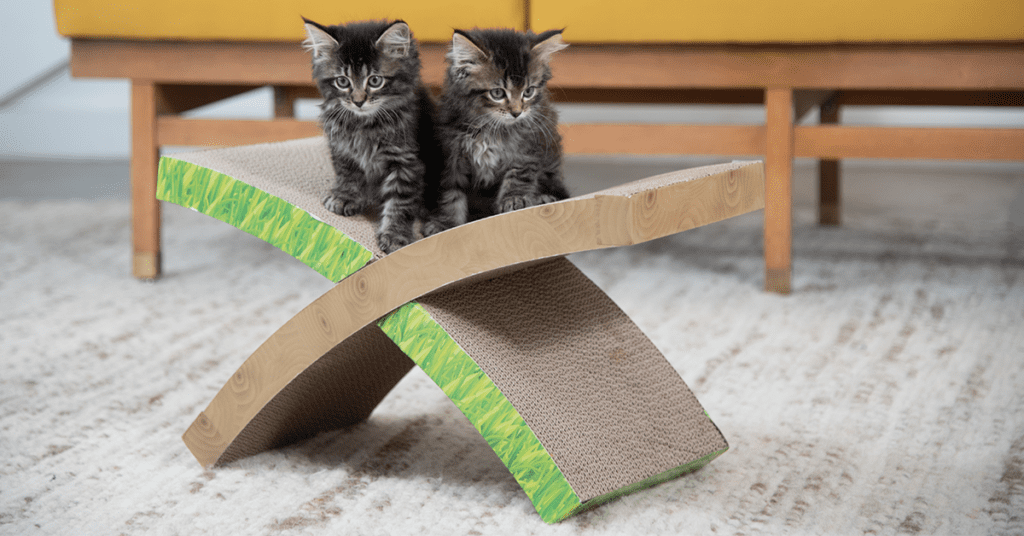
Your cat’s claws are made of a protein called keratin, the same as your fingernails. Unlike our fingernails, claws peel off in layers like an onion. Scratching helps peel off those layers and leave behind a shiny, sharp, new claw.
Sharp claws help your kitty catch (and kill) prey. If you’ve ever seen your cat hunt a mouse or other small creature, then leave it for you as a “gift,” you know.
If you’re like most cat moms, you want your cat to scratch something appropriate and not your carpet, furniture, and doors.
How to Redirect Your Cat From Scratching Your Furniture to a Scratching Post
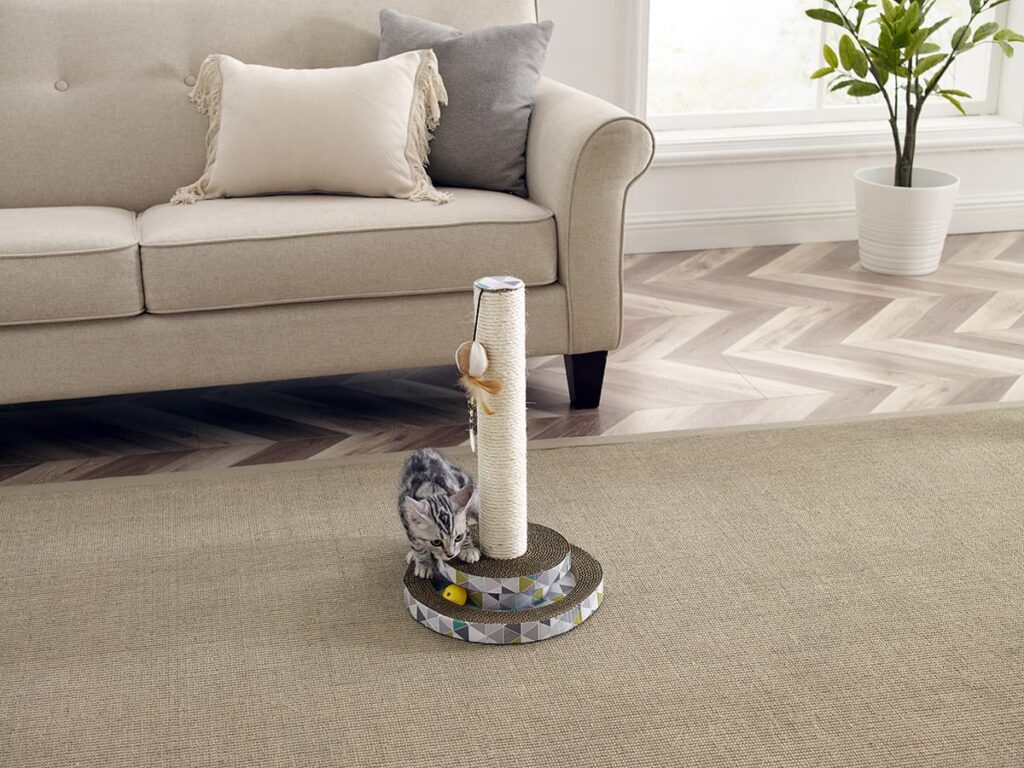
No one wants their custom-made leather club chairs to become a scratching post. Yet, a cat behaviorist will tell you that it’s not on purpose. It’s simply in your kitty’s nature, and they’re demonstrating their affection.
That’s right; your cat wants to claim you and let everyone else know you’re connected. When they scratch your favorite furniture, they leave their scent and physical mark behind. This is a sign to other animals. If you have multiple pets, some cats want to scratch even more.
The trick to redirecting your cat’s scratching behaviors so that you’re both happy is to offer them a scratching post near your hang-out spot. Some kitties will appreciate a special napping spot next to you or a catnip-infused toy with an excellent scratching surface.
The Humane Society of the United States suggests putting double-sided sticky tape either on the furniture itself or on the floor nearby to deter your kitty. Cats don’t like having sticky paws! Aluminum foil or using a deterrent spray like apple cider vinegar works to deter cats from the area as well (see: How to Keep Your Cat Out of the Christmas Tree).
You can also offer your cat a scratching post toy as an alternative. If your cat is stubborn, you can also try vinyl nail caps. They stick to the nail and don’t get in the way of the cat’s natural movements, but they do protect your furniture.
If you have a new cat, you can start them off right with a cat tree or other high-quality scratching pad to use as an outlet for their natural behaviors.
How Cat Scratchers Can Keep Your Cat Happy
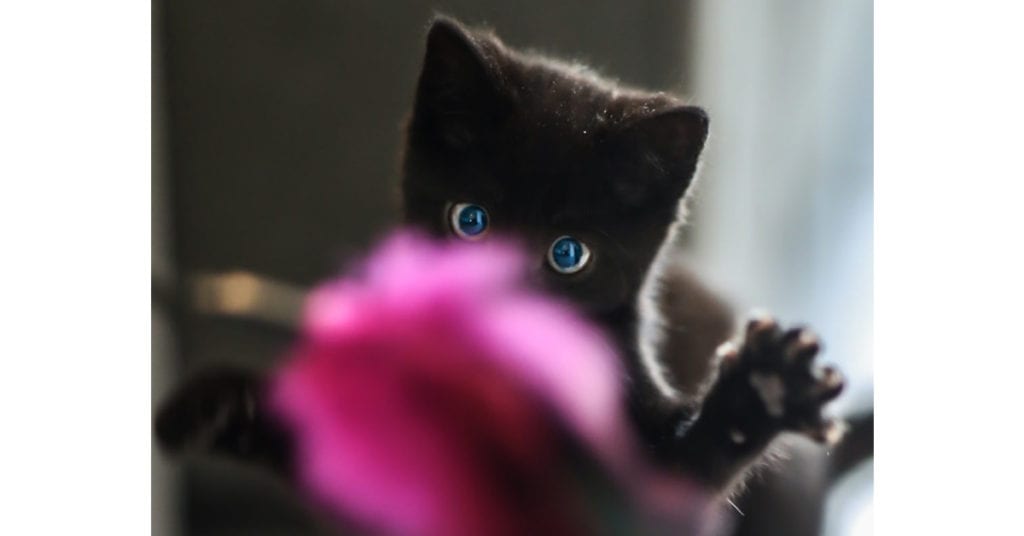
Depending on your cat’s age and lifestyle, they’ll prefer different types of cat scratchers. Some cat scratching posts are cat toys with balls and feathers for kitty playtime. Cats of all ages need the mental stimulation of play, and if you encourage them to bat the ball around and play with them, then they’ll appreciate it. Plus, it’ll encourage them to scratch the appropriate surface.
If you have a kitten, you can train them from kittenhood to use their scratching pad and let you trim their nails. If you have a grown cat, you may need to use additional techniques such as double-sided sticky tape or sandpaper on your furniture to retrain them to use a cat tree. Bullock also recommends offering your cat both a horizontal and vertical scratching post because every kitty has different preferences.
What Scratching Materials Do Cats Like?
Cats like tree bark, sisal rope, and even corrugated cardboard (especially if it’s infused with catnip.) They also like leather, wool, and all fabric types, as you may have noticed if they scratch furniture.
You probably know your cat’s favorite scratching spots. Help them mark territory with a scratching pad and not your furniture.
How to Care for Your Cat’s Nails
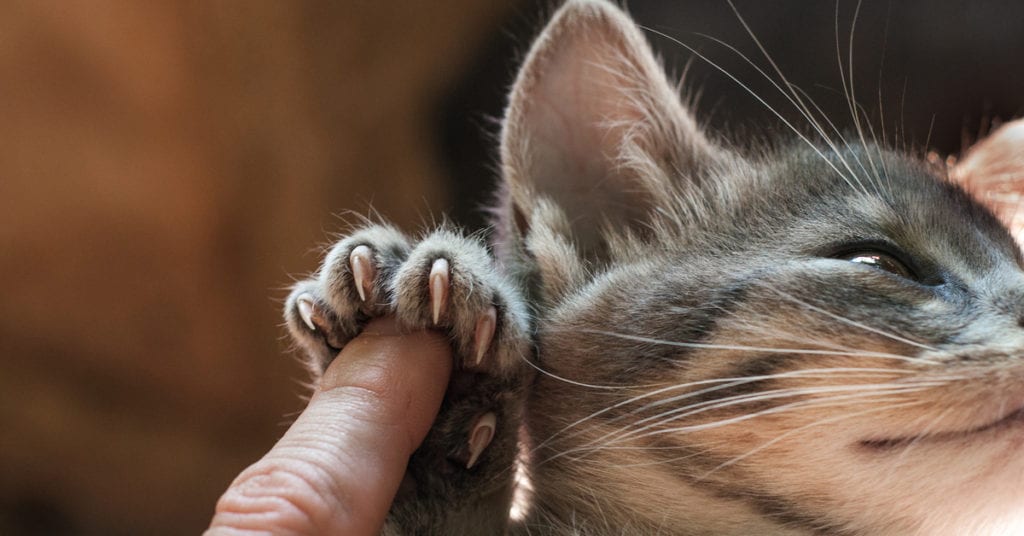
If your cat is tearing up your furniture, walls, and other areas, then you’ll probably need to start trimming their nails.
Like brushing, it’s best to wait until your cat is calm and hanging out nearby. If you’re petting your cat and the kitty is relaxed, this can be a good opportunity. You’ll want sharp nail clippers designed for kitty claws. Gently, calmly, take your cat’s paw, press it a little to unsheathe the claw, and then trim carefully.
It may take a few sessions to get all your cat’s claws, especially if it’s the first time. Most cats need claw trimming every four weeks or so. If your cat refuses to let you trim those nails, then you’ll probably need to pull in the experts via your veterinarian or groomer.
Declawing Is Not the Answer
People often misunderstand the purpose of cats’ claws. For years, cat owners thought if they declawed their cat, they’d solved the scratching problem. After all, if you have an indoor cat, you might think they don’t need their claws since they’re not hunting for food. Why not declaw? From a person’s point of view, it makes sense.
However, it turns out that cat claws are necessary. Not only do cats have an instinctual need to scratch and stretch out those claws every day, but they also help your cat balance while walking. Declawing, it turns out, is an amputation.
According to the Humane Society, declawing a cat is akin to cutting off your own finger at the last knuckle. Not only is it painful for your kitty, but because they use their claws to balance and walk, they have to learn to walk all over again. In fact, it’s so cruel that declawing is now banned in many countries and some states.
DO not declaw your cat. There are better ways to save your upholstery in a cat household. You can recognize this typical cat behavior and help your kitty with vertical scratching options like posts.
Now that you’ve learned why cats scratch and how to curb destructive scratching, you can help them follow their natural cat behavior and save your furniture. Which cat scratchers will your cat love?
For more information on keeping your kitty happy and healthy, check out:
8 First Time Cat Owner Tips All Prospective Kitty Parents Should Know
Looking for a new scratching post? Here are some great options below to give your kitty a designated scratching area.
Scratch, Snuggle & Rest Cat Scratcher
$16.99 $13.99
The Easy Life Scratch, Snuggle & Rest by Petstages is sure to be your kitty’s favorite perch and scratching post! This sturdy and lightweight scratcher platform is made from high-density cardboard that is constructed to last through hours of scratching. Great for redirecting destructive clawing behavior away from your furniture this bowl-shaped scratcher also comes with catnip to keep your kitty enticed…
Fold Away Tunnel and Cat Scratcher, Multi
$19.99 $14.99
The Fold Away Scratching Tunnel by Catstages is the ultimate feline hide-a-way. This durable, foldable tunnel has a soft, comfortable floor for superior cat naps and is made of recycled corrugated material that’s great for scratching. The contrast in textures makes this hiding spot all the more exciting for cats who prefer solo playtime, while the scratchable corrugate keeps cats nails trimmed and healthy…
Scratch & Groom Cat Scratch Pad, Tan
$18.99 $16.99
The Petstages Scratch & Groom set is the perfect self-grooming scratcher for owners and cats! Designed with high-density corrugated cardboard for the scratcher pad and an arched bristle brush for removing loose fur and providing a gentle massage for your kitty. Great for reducing the amount of fur and tear marks on your furniture by redirecting destructive behavior in a positive way. Blasted with dry…
Easy Life Hammock Cat Scratcher, Multi
$19.99 $18.99
The Petstages Easy Life Hammock Cat Scratcher is a fan favorite among cats! Constructed from thick, corrugated cardboard to withstands cats weighing up to 20lbs and under, this 2-in-1 lounge scratcher keeps your kitty’s claws healthy while proving a perfect place to perch. This lounge scratcher is easy to assemble with two pieces that glide in together to create the “X” design. Catnip included to entice…



